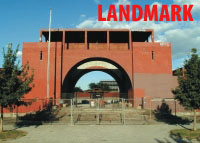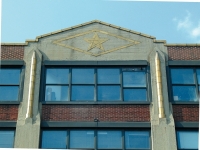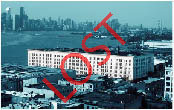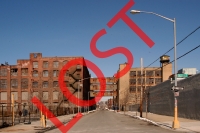UPDATE: Domino LPC Hearing
The Landmarks Preservation Commission held its first hearing on the Domino designation this morning. The hearing was held before a packed room of onlookers and speakers, and lasted just over an hour or so. So as not to bury the lede: no one spoke against the designation of the main Domino refinery building. Just about everyone favored the proposed designation, although some (like WPA) thought that LPC could go a little bit further.
After a presentation by LPC on the history of the refinery building and the site, the owner of the property, Community Preservation Corporation, was the first to speak. As they have in other venues, CPC spoke in favor of the refinery building. Michael Lappin, the chair of CPC, stated that their mission was primarily to build housing, but that CPC believes that the site is significant and that they can (with some considerable effort) adapt the refinery for new uses. Lappin was followed by Robert Silman, a noted structural engineer who has worked on numerous historic properties. Silman noted the structural challenges of adapting a building that has very few floors and a structural system that is actually underbuilt. Frank Sciami of Sciami Construction also spoke on behalf of CPC, and described the construction challenges that confront them in converting the building.
Sam Rockwell, representing Councilmember David Yassky, also testified in favor of the designation. Yassky noted that this should be a first step in the preservation of more of Brooklyn's - and the city's - waterfront.
A representative from the Pratt Center for Community Development gave very strong testimony not only favor of this designation but supporting preservation as an important part of community building in general. Pratt singled out the loss of the Dutch Mustard building and other industrial buildings as evidence of the problem, and denounced the practice of many in real estate market of pitting preservation against affordable housing. Their statement closed with a call for the city to establish a broader framework that would support both affordable housing and preservation as complementary goals.
Others speaking in favor designation were the New York Landmarks Conservancy ("enthusiastically supports"); the Society for Industrial Archaeology; the Historic Districts Council; the Society for the Architecture of the City; the Municipal Art Society; the Metropolitan Chapter of the Victorian Society of America; WPA (of course); and the North Brooklyn Alliance. All of these groups supported the designation, but also supported the idea of designating more than just one building. SIA raised the issue of former Domino buildings that are not part of this development site, something we thought was very important, and so far overlooked.
The only non-positive voice was that of Churches United, who testified (more or less) that they would be OK with preservation, so long as it didn't cut into the currently proposed number of affordable housing units (600+ in CPC's latest plan). One member of CU suggested that LPC base its decision to designate solely on the affordable housing question - an interesting proposition, given that that is not what LPC is empowered to do. Still, the bottom line for Churches United seems to be that do not support designation, but they do not oppose it either.




